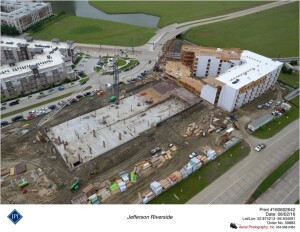Visual Technology Advances the Construction Process
2017 Concept Community developer JPI experiments with cutting the construction time line using modern visual aids.
Experts at JPI, developer of this year’s MFE Concept Community, are evaluating how new technologies, including advances in prefabrication, can shorten construction time lines. The firm incorporated prefab in the 2017 Concept Community, but it wants to go further, studying how internal and external building operations can benefit from having the right technology at one’s fingertips. Drones and virtual reality are two such technological advances the Irving, Texas–based developer is focusing on in its work.

Drones: Speeding Construction
Drones help improve productivity in construction by enabling project managers to observe the building process in real time. The surveillance footage the aircraft record can also be sent on a monthly basis to lending agencies and corporate executives to keep them apprised of a development’s progress.
But why stop with just drone photography? JPI envisions that drones will soon become a part of the construction work itself.
“Drones could immediately deliver needed supplies to the jobsite, in minutes [rather than] days,” says David Helms, senior design manager at JPI. “Even on-site, resupplying a carpenter with nails or an electrician with wire could save many lost manhours of moving up and down ladders, walking across the site to the supply trailer, and returning again to resume work. A drone can make that happen in minutes.”
The use of drones in construction is still being refined, as the relevant codes and standards are worked out and industry players figure out the cost versus value of the technology. But the potential of drones in apartment development is clearly promising.
Virtual Meetings: Facilitating Timely Decision Making
Real-time decisions are critical in many projects. Before the advent of communication technologies, when a problem arose, for example, construction would have to come to a complete standstill until the project management team was able to meet face-to-face.
Today, field personnel can communicate in real time via hand-held smart devices. On-demand communication between the project manager, design manager, architect, engineers, subcontractors, and suppliers can speed decision making without slowing construction.
Team communication now can also be enhanced with virtual reality (VR). Team members, and clients, can “tour” a floor plan before the building is constructed, to identify problem areas and create workarounds before costly mistakes are made. VR technology can also be used, along with smartphone photography and transmissions, to provide a photographic history of sitework, a critical element in record keeping, project reporting, and inspections.

Cost Savings Beyond the Construction Stage
The construction time savings that digital photography, drones, and VR can provide is but one example of the advantages these visual technologies can afford developers.
The planning process that takes place before the actual building begins also benefits, says JPI’s Helms, who notes the great “effort that goes into scheduling the work in logical sequences [to] ensure maximum production.”
In order to stay ahead of rising construction costs, he adds, developers will need to continue to challenge themselves to keep up with industry standards relative to the latest tools, equipment, and personnel.
“The fundamental question in [development] cost savings is, are we doing the best we can with what we have, and do we have the best that’s available?” Helms says.